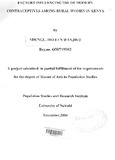| dc.description.abstract | This study examined the factors influencing use of modem contraceptives among rural
woman in Kenya. The general objective of this study was to investigate factors
influencing modem contraceptive use among rural women in Kenya. The study had three
specific objectives: to explore selected cultural factors influencing the use of modem
contraception among rural women in Kenya, to determine selected socio-economic
factors influencing the use of modem contraception among rural woman in Kenya and to
examine selected demographic factors influencing the use of modem contraceptives
among rural women in Kenya.
This study utilized the 1998 Kenya Demographic and Health Survey and was limited to
rural women aged 15-49 years, and had had sex at the time of the survey. Two main
methods of analysis were used to achieve the above objectives. Cross tabulations were
carried out at the bivariate level to assess the association between contraceptive use and
each of the variables, while logistic regression analysis was used to obtain the factors
influencing modem contraceptive use among rural women in Kenya.
'.
The bivariate results obtained in this study revealed a statistically significant association
between all variables taken into consid,eration in this study. These variables include
region of residence, level of education, religion, ethnicity, age of woman, marital status,
number of living children, age difference with partner, husbands approval of family
planning, discussion of family planning with partner, exposure to media and modem
contraceptive knowledge.
The logistic regression results showed a statistical significance between husbands
approval of family planning and contraceptive use. Women whose husbands approved of
111
family planning were twice more likely to have ever used a modem contraceptive
compared to those whose husbands disapproved.
Discussion of family planning with partner was also an important factor influencing
modem contraceptive use. Women who discussed family planning with their husband
more oftenly were two times more likely to have ever used a modem contraceptive as
compared to those who never discussed. Knowledge of modem contraceptives also does
influence modem contraceptive use as women who knew at least six modem methods
were more than 2 times more likely to have ever used a modem contraceptive as
compared to those who knew less than six methods. It is worth noting that the modem
methods include pills, Intra-uterine devices(nID), injections, condoms, implants,
diaphragm/foams/jelly, female sterilization, and male sterilization.
Exposure to media is another factor that influences modem contraceptive use. Women
who had heard family planning messages on the radio were at least 1.2 times more likely
to have ever used a modem contraceptive method than those who had not heard.
The main recommendations of this study were that education should be emphasized for
all persons-both male and female in order to promote contracepti ve use. It was also
recommended that mass media campaigns for family planning be intensified and done in
a simple language for easy understanding to persons of all ages. These campaigns should
be done at a time when they will reach a greater audience. | en |

